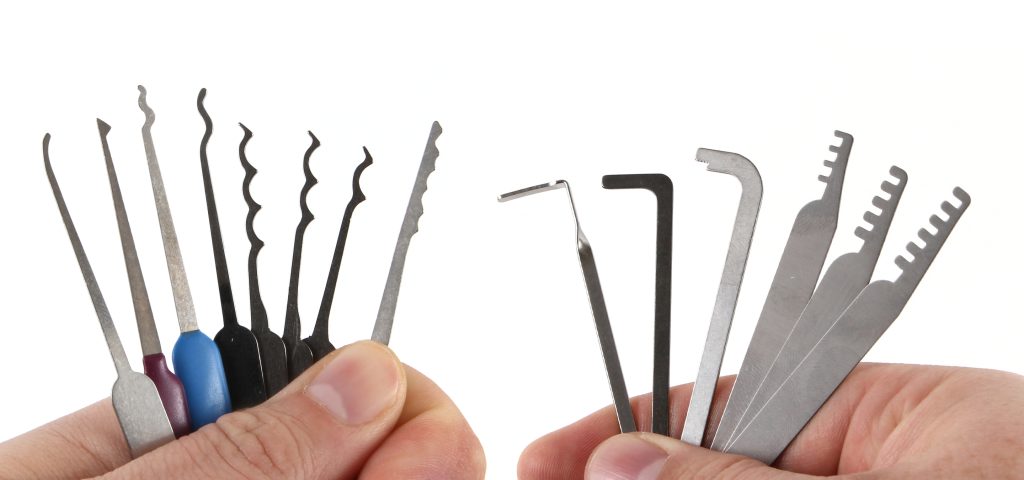Rake, hook, pick; no we’re not talking gardening tools, we’re highlighting the differences between lock pick types. If you’re just starting with lock picking, you should check out this Lock Picking 101 article to review some of the basics of how locks work and the basic techniques for picking.
Side Note: The pick types we discuss below are focused on picking pin and tumbler locks, so you won’t find any confusing off-the-wall types.
Lock Pick Types
Single Hook Pick
The Hook Pick is the bedrock of single pin picking on a standard lock. Think of this pick as the default starting point and tool that should be mastered first.
Half Diamond Pick
Useful for locks with pins that have very little variations in length. For most standard door locks, the pin heights will be too different for a Half Diamond to be effective, but if you have a lock with small variations, this pick will keep the height even while you’re picking.
C-Rake / Snake
Rake picks are used when time is of the essence and work by mimicking a key sliding in and out of a lock. This technique, coupled with holding tension, can cause the driver pins to jump above the shear line and open the lock. The C-Rake or “Snake” is a compressed rake that can move quickly and lift the pins inside a lock.
Stretched Rake
This tool is similar to the C-Rake, but is stretched out a bit, allowing the pick to contact more pins at the same time as it moves back and forth. This is one of our preferred rakes and offers a great “all-around” option.
Dual/Triple/Quad Rakes
These rakes all serve the same purpose and vary in length depending on the lock you’re using them with. The pointed peaks make them great for fast raking and these will usually be some of the fastest tools you’ll use.
L-Rake
The L-Rake is actually not a rake at all, but a lifting tool used to approximate the entire keyway at once. Think of raking as scrubbing back and forth, getting individual pins to set quickly, while lifting is moving the tool up and down slightly in an attempt to get all the pins to set at once. When these picks work, it feels almost like magic, but unfortunately they rarely do.
Tension Tool Types and Comb Picks
Twisted Tension Tool
Even the fanciest pick is no good without a decent tension tool literally taking up the slack. As you progress with picking, you’ll find that the real art is holding the proper tension on a lock.
The Twisted Tension Tool is our favorite, as the twist in the handle creates a nice flat surface for your finger to lay on while picking. We find this also helps when varying the tension to get that one stuck pin to finally come loose.
Flat Tension Tool
Often double-sided, these tension tools aren’t as nuanced as the twisted variety, but their flat profile means you can store them nearly anywhere without taking up space.
Top-of-Keyway Tension Tool
Some locks just don’t have enough room to fit a standard tension tool and this is where these shine. With small teeth cut in at the ends, they allow you to apply tension from the top of the keyway, while still being able to fit the picks into the body of the lock.
Comb Picks
Comb Picks are another victim of “misnaming” in that they are really more bypass tools and aren’t picking a lock to mimic the key shape. Comb Picks exploit padlocks that have keyways drilled too far into the body of the lock. They work by lifting the entire pin stack (key pins, driver pins and springs) all the way past the shear line so the cylinder will turn.
Conclusion
This is just a small snapshot of the lock picking tools available on the market and as you progress, you’ll likely find that you keep coming back to just one of two of them. If you’re feeling a bit lost and looking for a good place to start, consider picking up our Lock Picking Starter Pack. It includes a Single Hook, Stretched Rake and Twisted Tension Tool, along with other valuable tools for learning and practicing lock picking.
